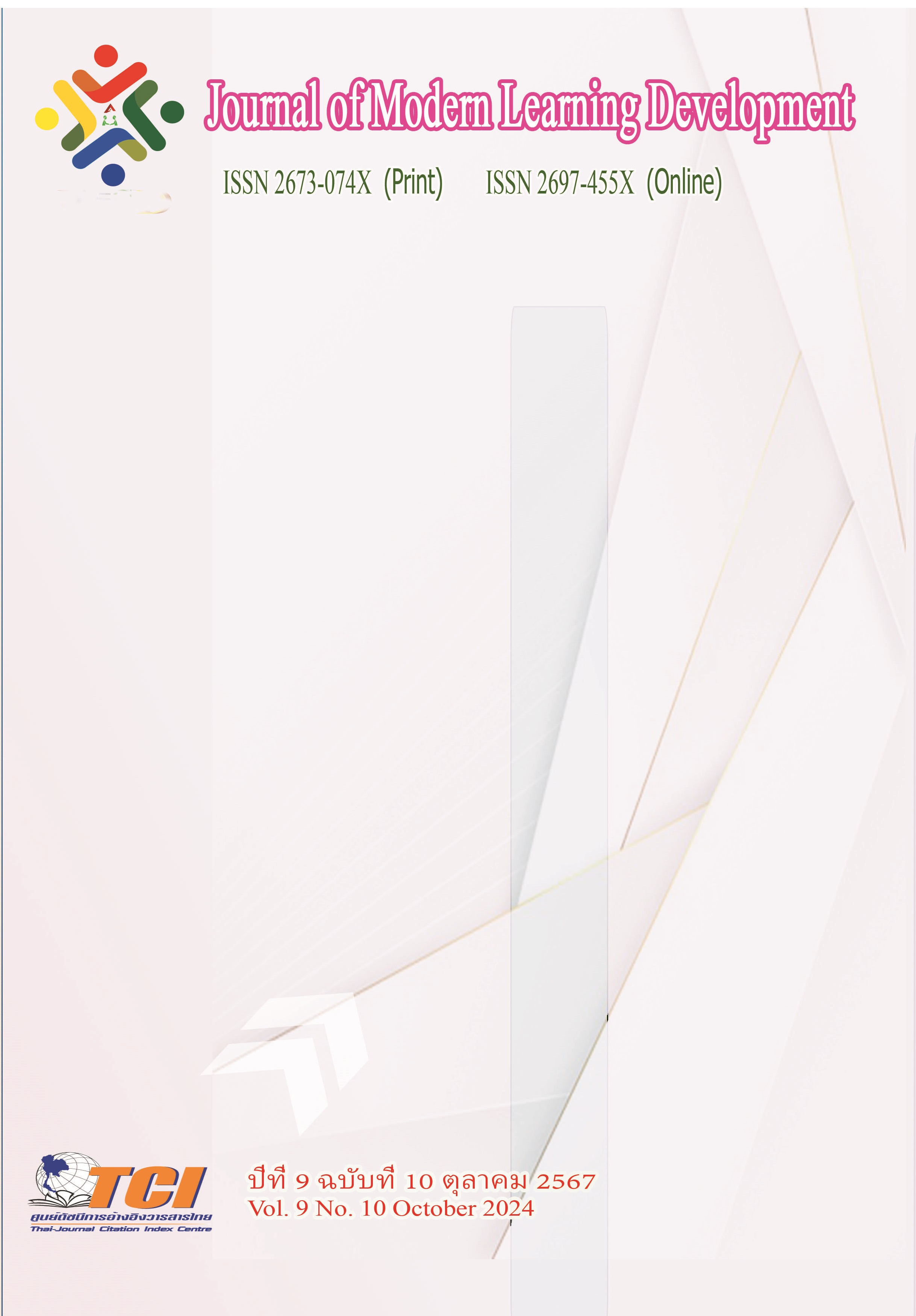The Tibetan Reba Drum Dance: Inheritance and Development in the Context of Chinese National Policy
Main Article Content
Abstract
The objectives of this research were: 1) Explore the historical background of the Tibetan Reba Drum Dance, including its origins, cultural roots, and early development stages. 2) Analyze the inheritance and evolution of the Tibetan Reba Drum Dance, focusing on how it has adapted to societal changes and modernization while preserving its traditional essence. 3) Examine Chinese policies regarding the protection and promotion of the Tibetan Reba Drum Dance, assessing their effectiveness in safeguarding intangible cultural heritage and fostering cultural appreciation and education. This study adopts qualitative research methods , the sample studied includes Reba folk artists in Tibet, China, and professors and experts from Tibet University. Research tools include questionnaires, interviews and observations. Collecting data from literature and the field, and analyzing it through field imterviews, comparative research,and observation and discussion.
The research results were found as follow: 1) The Reba Drum dance originated in Tibet, and its history can be traced back to Tibetan Buddhism hundreds of years ago. 2) Tibetan Reba dance is the spiritual culture and wealth of the social life development of the Tibetan people. After long-term historical accumulation and practice, it has gradually evolved into A dance art culture rich in unique Tibetan style and of great development, inheritance and research value. 3) Tibetan Reba Drum Dance has been listed as a national intangible cultural heritage and runs through the Chinese national education system. With the support and encouragement of relevant national policies, Tibet Reba drums are booming.
Article Details
References
Yu Shan. (2018). Analysis of Bon cultural relics from Reba dance. Tibetan Art Research. (04), 59-64.
Liu Jia. (2015). "Oriental Gypsy" Dance: Tibetan Reba Dance. New Long March (Party Building Edition). (08), 60.
Xiao Weibing. (2004). Holding special teaching on Reba drumming. (eds.) Beijing Education Yearbook. Kaiming Publishing House, 179.
Li Xin. (2019). Comparative study of the "intangible cultural heritage" hand drum dance between China and South Korea from the perspective of different cultures. Art Criticism. (06), 57-60+109.
Zhao Runbo. (2004). On the origin of Tibetan "Reba". Yunling Song. (02), 46-47.
Li D. (2020). Analysis of the value of Tibetan Reba drum dance in college dance majors. Popular Literature and Art. (23), 200-201.
Sun Wenxue. (2019). Research on the artistic characteristics and cultural connotation of Tibetan Reba Dance (Master’s thesis, Jiangnan University). https://kns.cnki.net/ KCMS/detail/detail.aspx?dbname=CMFD202002&filename= 1020007544.nh
Gao Yongpeng & Zhang Nan. (2019). Traceability·Nirvana - Enlightenment from the men's Reba group dance "The Commoner". Sichuan Drama. (05), 162-164.
Zeji. (2018). Summary of the "First Region-wide Reba Dance Performance and Reba Art Summit Forum" and others. Tibetan Art Research. (04), 37-43.
Yan Yuwen. (2018). "Dancing with the drum, wherever the heart goes" - the protection and inheritance of the "intangible cultural heritage" Tibetan Reba dance. Drama House. (26), 120.o
Hongxing Yangzong. (2018). Research on intergenerational inheritance of Dingqingkang Shareba in Tibet - the life history of artist Tashi Quzhen. Journal of Ethnology . (01), 68-80+126-128.
Zhou Xiangfei, Luo Min & Arongjiacuo. (2009). A brief review of the Tibetan folk song and dance "Reba" in Kham, Western Sichuan. Journal of Mianyang Normal University. (10), 128-130.
Liu Mijia. (2010). A brief discussion on the development space of Tibetan Reba dance in Chinese folk teaching. Education and Teaching Forum. (12), 108-109.
Kang Kelsangmeduo & Ngawang. (2007). The passionate Tibetan folk Reba song and dance. Tibetan Art Research. (04), 26-32.
Hong Tao & Kelsang Qujie. (2008). A brief discussion on the development of Reba Dance. Tibetan Art Research. (02), 43-45.
Liu Bo. (2021). Research on folk aesthetics of Tibetan folk "Reba" art. Journal of Sichuan Normal University (Social Science Edition). (01), 159-165.
Li Da & Xiong Yan. (2018). Analysis of the value of Tibetan Reba drum dance in folk dance classroom teaching. Popular Literature and Art. (09), 195-196.
Cong Shuaishuai. (2017). The beauty of composite Reba dance. Dance. (03), 63-65.
Qiangba Qujie & Tseden Dolma. (2018). Research on drum dance culture in Tibet. Journal of Beijing Dance Academy. (01), 80-86.
Kelsang Qujie. (2012). Analysis of the cultural characteristics, evolution and development of Reba dance music. Tibetan Art Research. (01), 39-46.
He Yunfeng. (2007). Originally from the same origin—the origins of the Naxi “Leba” and the Tibetan “Reba”, Liubian, and Current Analysis. Tibetan Art Research. (01), 23-34.
Omega Can. (2012). Basic procedures for traditional "Reba Tambourine Dance" performance. Tibetan Art Research. (01), 33-38.
This magazine. (2018). Listen to the call of the earth and ask for directions to the holiness of the snowy land - "Heavenly Dance Style" original Tibetan-themed dance performance. Dance. (01), 6-11.
Yang Congbiao. (2010). A brief discussion on Reba Art. Tibetan Art Research (03), 22-23.
Qizhu Dorji. (2006). "Dingqing Reba" dance on the grasslands of eastern Tibet. China Tibet (Chinese Edition). (06), 50-53.
Tang Baijing & Guo Airi. (2021). Chinese folk dance creation under the concept of Chinese national community—also a review of the group dance work "Chengyi Reba". Dance. (04), 83-88.
Yang Congbiao. (2005). Reba is passionate and tambourine is affectionate. Chinese Music Education. (07), 46.
Wang Wei. (2022). Interpretation of men’s Xuere Baldang drum dance. Shang Wu. (11), 80-82.
Li Shuying. (2022). Analysis of the creation of the dance drama "Drum of Life" https://kns. cnki.net/KCMS/detail/detail.aspx?dbname=CMFD202202&filename=1022482841. nh
Gao Zixuan. (2020). On Reba Art and its Basic Functions (Master’s Thesis, Tibet University). https://kns.cnki.net/KCMS/detail/detail.aspx?dbname=CMFD202201&filename=1020319412.


